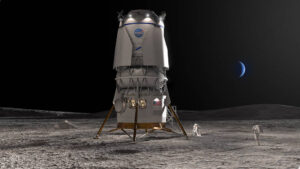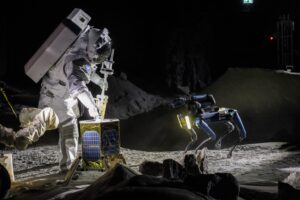Crowdsourcing has transformed space exploration by making it more open, cost-effective, and collaborative. Although previously dominated by government agencies like NASA, ESA, and Roscosmos (in Russia), the sector has expanded to include private companies, citizen scientists, and volunteers contributing data, ideas, and even funding.
There’s a popular anecdote about U.S. President John F Kennedy visiting the NASA space centre in 1962. He had united and inspired much of the country behind an aim to put the first man on the moon. During his visit, he walked over to a janitor carrying a broom and said “Hi, I’m Jack Kennedy, what are you doing?” The janitor replied, “Well Mr. President, I’m helping put a man on the moon.” Crowdsourcing can be seen as today’s equivalent to let people in any walk of life, anywhere in the world, to “buy in” and feel part of space missions.
The democratisation of space makes many people feel more connected to space missions when they can actively contribute, fostering a stronger global space community. Space organizations find they get more political and financial support when the public is engaged. Also, with decentralized decision-making and wider global participation, space exploration becomes a more international and cooperative effort rather than being dominated by a few nations. It means so many more people can make a contribution. Let’s go into this in more detail.
Examples of How Crowdsourcing Has Changed Space Exploration
1. Citizen Science and Data Analysis
Galaxy Cruise, launched in 2022, is a citizen science project combining volunteer efforts with artificial intelligence to analyse data from the Subaru Telescope. This is the 8.2-metre telescope of the National Astronomical Observatory of Japan, located at the Mauna Kea Observatory on Hawaii. The purpose of Galaxy Cruise is to identify and classify various galaxy types, including rare formations such as ring galaxies. Over 10,000 volunteers have contributed to the classification of galaxies, resulting in the discovery of around 430,000 galaxies, significantly enhancing our cosmic catalogue.
Taking part is free, and potential participants are required to play an online game that establishes their credentials to become a Citizen Astronomer.
Zooniverse allows volunteers to be part of classifying galaxies and discovering exoplanets by helping to analyze telescope data.
In the 2000s, NASA’s Clickworkers provided valuable crowdsourced crater classification on Mars.
2. Crowdfunding for Space Exploration
Space exploration includes the use of telescopes from Earth as well as actual travel through space, and encourages individuals to become citizen scientists.
The crowdfunding platform Kickstarter has hosted an array of opportunities to donate to telescope development, including the Eolisa Space project, or to acquire an astronomy telescope for personal use, such as the VeeGaze startup smart telescope for beginners.
When it comes to actually being in space, the non-governmental, non-profit U.S. organisation The Planetary Society, has been crowdfunding space projects for four decades. In 2015, the original LightSail mission was to verify the ability of satellites to run on solar power gathered by deploying sails. It was the first experimental spacecraft funded entirely through crowdfunding. Unfortunately, its deployment orbit was not high enough to escape Earth’s atmospheric drag and demonstrate true solar sailing. LightSail2 launched on 25 June 2019, and in a much higher low Earth orbit its solar sails were deployed on 23 July 2019. It remained in orbit more than three years and re-entered Earth’s atmosphere on 17 November 2022.
Over the project’s 10+ year history, almost 50,000 people from over 100 countries contributed more than US$7 million US dollars to make it a reality.
A few business startups in the space exploration sector have offered shares in their companies through equity crowdfunding. Founded in 2017 and headquartered in Luxembourg, Kleos Space delivered global activity-based intelligence and geolocation as a service. It utilized the UK equity crowdfunding platform Seedrs in 2018 to raise early funds. Other fundraising took place before it went public in 2020 and realised €11.7m on the Australian stock exchange. Even though it ran out of funds and filed for bankruptcy in 2023, public crowdfunding had given this startup an opportunity.
3. Open Innovation & Hackathons
NASA’s Open Innovation Challenges consist of prize-based competitions for solving space-related problems. NASA has found that using open innovation challenges outside its internal, tightly regulated internal processes and procedures can deliver solutions faster and more cost-effectively.
NASA’s Space Apps Challenge is a global hackathon where coders, engineers, and designers solve space-related challenges. The 2024 winners were announced January 31st, 2025. In its biggest ever yet edition, over 93,500 people from more than 163 countries and territories submitted 9,900 projects.
4. Decentralized Satellite Launches & Data Sharing
CubeSats are small, affordable satellites made up of standard size units that each weigh less than 2 kgs (4.4 pounds). In the 25 years since being initially developed as educational tools, they are commonly deployed in low-Earth orbit for applications such as remote sensing, space weather measurements and communications. Their modular design and use of off-the-shelf subsystems from different suppliers allows CubeSat projects to be typically readied for flight within one or two years, democratizing access to space.
The Open Space Agency, based in London, UK, has an aim to unlock the talent and insight of citizen scientists around the world as space explorers. Its Ultrascope project, which is “developing a range of open source automated robotic observatories (ARO) that are capable of capturing pro-level images of celestial objects” will allow amateur astronomers to contribute. It is developing a 3D printable-telescope so that anyone can build their own one and take part. The latest design is still at an early stage that needs further refinement, and the Open Space Agency is currently looking for Beta Testers around the world to test the current scope design and suggest improvements.
New Big Players in Crowdsourced Space Exploration
SpaceX
SpaceX, founded by Elon Musk, uses crowdsourced feedback and live-streamed tests to engage the public. SpaceX has used crowdsourcing to resolve engineering issues. Also, a third-party crowdfunded pledges of over $11 million from investors who wanted to buy equity in SpaceX. The crowdfunding was a demonstrable way for aspiring investors to draw other everyday people in to the project, to make them concerned stakeholders who are more likely to talk about SpaceX with families, friends and colleagues. Crowdfunding boosts public engagement, can help build a brand, and along with other crowdsourcing activities it can provide an early indication of public interest in specific projects.
Blue Origin

Artist’s concept of the Blue Moon lander. Image source: Blue Origin
Blue Origin was founded in 2000 by Jeff Bezos, the founder of Amazon. Its use of crowdsourcing strategies and initiatives includes innovation competitions and its Club for the Future. This is a nonprofit organization that focuses on inspiring young people to pursue careers in STEM (science, technology, engineering, and mathematics).
Various innovation challenges that support STEM engagement include NASA’s Artemis Program Collaborations, in which Blue Origin has worked with NASA on initiatives like the Human Landing System (HLS) program, indirectly driving interest in STEM careers.
Planet Labs
Planet Labs is a publicly-traded company that was founded in 2010 with the mission to image the Earth every day and make change visible, accessible, and actionable. Its fleet of nanosatellites, called Doves, deliver mass high-resolution imagery of the globe, capturing unprecedented details every single day. This helps businesses, governments, and research institutions stay ahead in ever-changing global contexts and ultimately capture unforeseen windows of opportunity. Crowdsourcing space exploration through Planet Labs puts particular emphasis on creating value not just commercially, but for social good, by making the data accessible for sustainable development efforts.
Open Lunar Foundation
Since 2018, the non-profit Open Lunar has been incubating and building projects which contribute to cooperative lunar development. Its focus on setting the standards and establishing the infrastructure for lunar settlement, and then further in space on planets, spans responsible resource management, open data sharing, technical standards and protocols, and transparent coordination. This is all aimed at fostering a collaborative, co-created and resilient lunar environment.
The foundation collects and generates ideas year-round. Subsequent research results are shared as open publications, and their findings determine whether or not to build evidence-backed prototypes. Concepts with strong leaders and timely, feasible products or services can become independent development initiatives. Activities and research are continuously shared. This accelerates progress by allowing other people and organizations to contribute to the work.
Response from Traditional Space Agencies
Government space agencies have embraced crowdsourcing, and the involvement of citizen scientists, rather than push back or resist it.
NASA
The organization that landed the first men on the moon runs regular open innovation programs, partnering with private companies such as HeroX and Freelancer.com, and encourages people to take a role as citizen scientists. A landmark example of benefits from using a wider range of people than rocket scientist was a challenge to design foldaway radiation shields for protection. The winner was a performing artist who was inspired by origami techniques.
A more recent challenge was launched in September 2024, the LunaRecycle Challenge. It offers $3 million in prizes for innovations in recycling inorganic material waste on deep space missions. Phase One submissions are due by March 31st, 2025.
European Space Agency

Image source: Business In Space Growth Network
ESA & ESRIC (European Space Resources Innovation Centre) launched the Space Resources Challenge initiative launched in 2021 to promote challenge-driven innovation. It engages communities to explore innovative solutions for Europe’s space exploration programme; encourages industry and research institutions to compete for a prize; and supports the development of advanced methods for prospecting, extracting and utilising space resources.
On top of driving innovation, the Challenge can help kickstart new commercial endeavours, thus contributing to the creation of a vibrant Space Resources market involving stakeholders from the European industry. It encourages teams to develop pioneering technologies for prospecting, extracting, and processing resources from extra-terrestrial surfaces, with a particular focus on the Moon.
Another current challenge, for a different audience, is the Student Aerospace Challenge 2024-2025. Applications are now closed, though the competition has engaged 259 teams representing around 1,186 university students. Their work will continue up to a final event on June 5th 2025 at which students will present their designs for two crewed space travel vehicles. and the best-quoted projects will be rewarded with prizes.
Roscosmos & CNSA
Roscosmos (the Russian State Corporation for Space Activities) and the China National Space Administration have been slower to adopt crowdsourcing techniques, though China has engaged its public through livestreamed moon landings.
The Future of Crowdsourced Space Exploration
- Decentralized Space Missions: Blockchain and DAOs (Decentralized Autonomous Organizations) could fund and manage space projects.
- AI & Machine Learning Integration: Volunteers training AI models for space data analysis.
- Greater Public Engagement: Virtual reality and gamification could allow citizens to “explore” space missions in real-time.
- Space Tourism Crowdsourcing: Companies might use public input for designing space travel experiences.
Key Takeaway
Crowdsourcing space exploration has transformed it from a government-controlled sector into a global, participatory effort. The next major discoveries could come from ordinary people, citizen scientists, contributing extraordinary ideas.





0 Comments